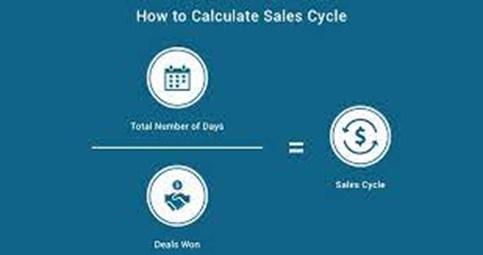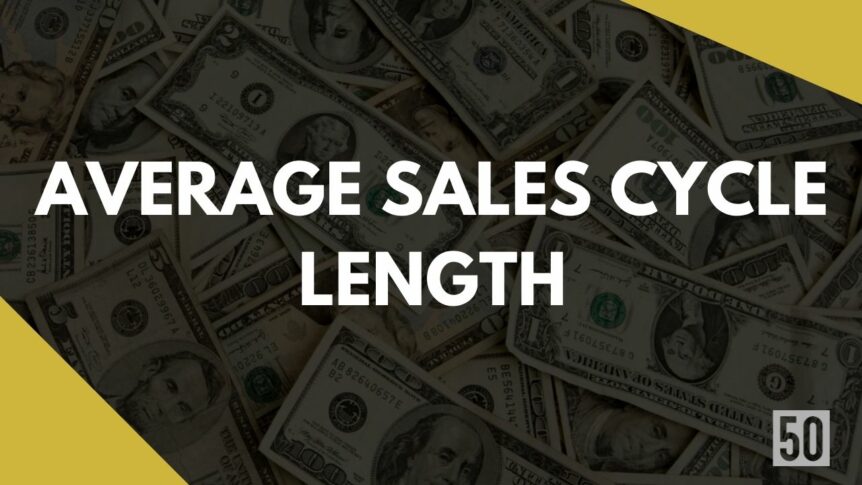It’s no secret that businesses need to track a variety of key performance indicators (KPIs) in order to succeed. But one KPI that is often overlooked is the average sales cycle length. In this post, we’ll explore why your business needs to track its average sales cycle length and how you can go about doing so. We’ll also provide some tips for reducing the average sales cycle length for your business. So, read on to learn more!
What Is Average Sales Cycle Length?
Average Sales Cycle Length is one of the sales metrics that measure the amount of time from your first touch with a prospect to closing the deal, averaged across all deals. The Average Sales Cycle Length metric is important because it helps sales reps and managers alike understand how long it takes to close a deal and what factors impact that timeline. By understanding the Average Sales Cycle Length, businesses can make adjustments to their sales process in order to shorten the cycle and close more deals.
Why Is It Important For Startups To Track Their Average Sales Cycle Length Metric?
The Average Sales Cycle Length metric is an important indicator of the health of a startup, providing insight into how well it is doing in terms of sales. By tracking this metric, startups can optimize their sales process and assess their performance against their competitors.
Knowing the average length of time it takes for potential customers to move from initial contact to the conversion will help startups identify areas for improvement and focus on strategies that increase their success rate.
In addition, having a clear understanding of the sales cycle length can help a startup set realistic goals and milestones, gauge customer interest, monitor sales progress, and generate meaningful insights from data-driven decisions.
The Average Sales Cycle Length metric provides valuable information that helps startups stay competitive and achieve sustainable growth. Ultimately, tracking this metric is essential for maximizing sales success and the overall health of a startup.
How Do You Calculate Average Sales Cycle Length?
When calculating your average sales cycle length, the first thing you need to do is determine the total number of days it took to close all deals. Then, divide that number by the total number of deals. For example, let’s say it took a total of 30 days to close 10 deals. The average sales cycle would be 3 days.

It’s important to keep in mind that this is just a general average. Your actual sales cycles will vary depending on a number of factors. By understanding your average sales cycle length, you can get a better sense of how long it takes to close a typical deal and plan accordingly.
What Factors Affect Average Sales Cycle Length?
The length of a sales cycle is affected by several factors which include:
The complexity of the product or service:
Generally, more complex products require additional time to research and understand. This means that a longer sales cycle length is likely if you are selling complex solutions such as enterprise software or custom services.
The size of the client organization:
Larger organizations typically have more steps in their purchasing process which can add time to the sales cycle.
The amount of competition:
If there are many competitors vying for the same customer, this could increase the length of a sales cycle as customers compare different solutions and take more time to make their decision.
The size of the purchase:
A larger purchase typically requires more effort and resources to process, which can add time to the sales cycle.
Sales rep skills:
If a sales rep is inexperienced or doesn’t have the knowledge required to properly explain your product or service, this could lead to a longer sales cycle as customers may not be able to get all their questions answered in a timely manner.
By understanding these factors and taking measures to address them accordingly you can effectively manage the length of your sales cycle and ensure a smooth sales process.
What Is A Good Average Sales Cycle Length?
The length of a sales cycle can vary depending on the product or service being sold. For example, a company selling a high-end piece of machinery is likely to have a longer sales cycle than a company selling an annual subscription to a software program. However, there are some general trends that can be observed in terms of the average sales cycle length.
For instance, 75% of the B2B companies take an average of at least 4 months to win a new customer. Additionally, the average SaaS B2B sales cycle length is about 83 days, according to a 2020 study led by Hubspot.
While these averages can provide some guidance, it’s important to keep in mind that the best way to determine the ideal sales cycle length for your business is to track your own data and metrics. By doing so, you can gain a better understanding of how your customers make purchasing decisions and what factors influence their decision-making process.
Industry Benchmarks and Examples
Implicit studied hundreds of businesses and discovered that the median time from Lead to Opportunity (MQL) to Sales Qualified Lead (SQL)) was 84 days and from Opportunity to Close (SQL) to Deal was 18 days, meaning the average Lead to Close length is 102 days. But this varied greatly based on the source of the opportunity.
| B2B Companies | Benchmark for Sales Cycle Length |
| Average Lead to Opportunity Length | 84 days |
| Average Opportunity to Close Length | 18 days |
| Average Sales Cycle Length | 102 days |
Strategies To Decrease The Average Sales Cycle Length
Implement a Lead Qualification System:
The first step to decreasing the sales cycle length is to implement an effective lead qualification system that can determine which leads are more likely to convert into customers and which ones should be set aside. This will help streamline the process and ensure that only qualified leads receive your sales presentations, greatly reducing the time it takes to close the deal.
Create Short, Concise Presentations:
If your sales presentations are dragging on for too long and are full of superfluous information, chances are that you’re not going to be able to convert as many leads into customers. By creating shorter, concise presentations that focus on the key benefits of your product or service, you’ll be able to capture the interest of prospects and help move them through the sales cycle more quickly.
Ask for Feedback from Prospects:
By asking for feedback from prospects, you’ll gain valuable insights into what is working and what isn’t in your sales process. This will allow you to fine-tune your approach, keep prospects engaged and move them through the sales cycle more quickly.
Utilize Automation:
Sales automation tools can help streamline and simplify many of the manual tasks associated with the sales process, such as creating presentations, tracking leads and sending out follow-up emails. By investing in a good automation tool, you’ll be able to move prospects through the sales cycle more quickly and efficiently.
Utilize Referrals:
Leveraging referrals from existing customers is a great way to reduce your average sales cycle length. You already know that these customers trust you and are happy with your product or service, so they serve as great advocates for your business. Asking these customers to refer you to their contacts can help you quickly gain new leads, generate more sales and decrease the average sales cycle length.
Provide Incentives:
Offering incentives to prospects is a great way to move them through the sales cycle more quickly. These incentives could include discounts, free shipping or additional services. Providing these incentives can help entice prospects to make a purchase decision sooner rather than later.
Set Sales Goals:
Setting specific sales goals and tracking progress towards them can help ensure that your team is focused on closing deals quickly and efficiently. This will also help keep everyone motivated and on track to reach the desired goals.
By following these strategies, you can significantly reduce your average sales cycle length and quickly acquire new customers. This will help improve your bottom line and ensure that your business is operating as efficiently as possible.
Tools To Measure The Average Sales Cycle Length
Measuring the average sales cycle length is an important part of managing a successful business. This helps to track progress in the sales process and identify areas where improvement can be made. There are several tools that can help to measure the average sales cycle length, including:
1. Sales Funnel Analysis
Tracking performance at each stage of the sales process can provide insight into how long it takes to close a deal. It also helps to identify any obstacles that may be slowing down the process and making it harder to close deals.
2. Lead Tracking Software
Keeping track of all customer interactions is critical for understanding how long deals take to complete. Lead tracking software allows businesses to track the time it takes to move a lead from one stage of the sales cycle to another.
3. Customer Relationship Management (CRM) Software
CRMs provide businesses with detailed data on customer interactions and track how long it takes for deals to close. This is extremely helpful for understanding where improvement can be made in the sales process and identifying areas where sales cycles can be shortened.
By utilizing these tools and tracking the average length of the sales cycle, businesses can make adjustments to their processes and find ways to close more deals faster.
Conclusion
Your business needs to track its average sales cycle length for a multitude of reasons. By understanding your company’s historical data, you can make more informed decisions about hiring, budgeting, and goal-setting. In addition, tracking your average sales cycle length will help you improve your customer relationships by identifying areas where the process can be streamlined. Finally, benchmarking yourself against other businesses in your industry will give you insights into how you can further improve your own sales cycle. Implementing a system to track your average sales cycle length is essential to the success of any business.

